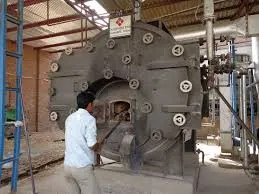
Nov . 16, 2024 09:43 Back to list
Optimizing Temperature Control for Hot Water Boilers in Heating Systems
Hot Water Boiler Temperature Control
Efficient temperature control in hot water boilers is essential for ensuring safety, maintaining energy efficiency, and optimizing performance. Boilers are widely used in residential and industrial applications for heating water, providing hot water for domestic use, and enabling various manufacturing processes. Effective management of water temperature not only helps in preventing overheating but also contributes to energy savings and prolonging the boiler's lifespan.
One of the key aspects of hot water boiler temperature control is the use of thermostats. A thermostat is a temperature-sensing device that automatically regulates the temperature of the water by turning the boiler on or off as needed. Most modern boilers are equipped with digital thermostats that allow users to set their desired water temperature precisely. This capability is crucial for enhancing comfort levels in homes while ensuring that the boiler operates efficiently.
In addition to thermostats, advanced control systems utilize sensors and feedback loops to monitor water temperature continuously. These systems gather data from various points in the boiler and adjust the heating output accordingly. This automated approach not only optimizes performance but also minimizes the risk of scalding hot water being delivered to taps and fixtures, thereby enhancing safety for users.
hot water boiler temperature control

Another important factor in boiler temperature control is the material and design of the hot water storage tank. Insulated tanks help in maintaining the desired temperature for extended periods, reducing the need for constant heating. This type of insulation significantly decreases heat loss, thus saving energy and reducing operational costs. Proper maintenance of the insulation layer is crucial for ensuring its efficiency and effectiveness.
Regular maintenance checks are also vital for effective temperature control. Sediment buildup can occur at the bottom of the boiler, affecting heat exchange efficiency and leading to overheating. Flushing the tank regularly, checking for leaks, and ensuring all components function well are necessary steps to maintain optimal performance. Additionally, checking the pressure relief valve is essential for ensuring that the boiler operates within safe pressure limits, further contributing to safe temperature control.
Moreover, incorporating variable speed pumps can enhance a boiler's efficiency by allowing for precise control of water flow based on demand. This adjustment helps match the heat output to the actual hot water usage, thus preventing unnecessary energy expenditure and ensuring that the temperature remains consistent.
In conclusion, effective temperature control in hot water boilers is paramount for safety, efficiency, and prolonged equipment life. By utilizing advanced thermostatic devices, ensuring proper maintenance practices, and optimizing system design, users can achieve significant energy savings while enjoying reliable hot water supply. As technology advances, more innovative solutions will likely emerge, further improving the efficiency of hot water boiler systems and reinforcing their critical role in modern heating applications. With proper attention and care, hot water boilers can serve reliably while minimizing their environmental impact.
-
High-Efficiency Commercial Oil Fired Steam Boiler for Industry
NewsJul.30,2025
-
High-Efficiency Biomass Fired Thermal Oil Boiler Solutions
NewsJul.30,2025
-
High Efficiency Gas Fired Thermal Oil Boiler for Industrial Heating
NewsJul.29,2025
-
High-Efficiency Gas Fired Hot Water Boiler for Sale – Reliable & Affordable
NewsJul.29,2025
-
High Efficiency Biomass Fired Hot Water Boiler for Industrial and Commercial Use
NewsJul.29,2025
-
High-Efficiency Biomass Fired Hot Water Boiler for Industrial Use
NewsJul.28,2025
Related PRODUCTS






















